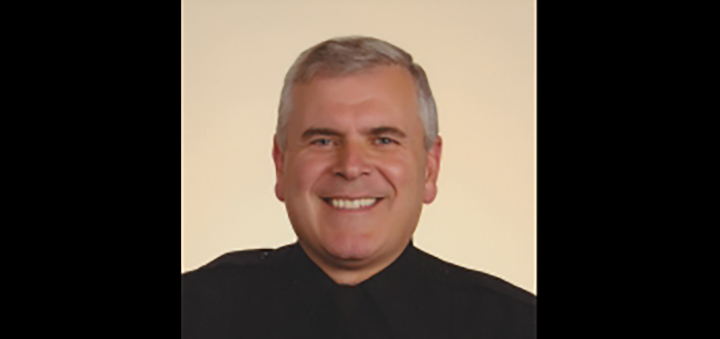The Norwich Police station turns 20
A Happy Anniversary is sent to the Norwich City Police, who have occupied 18 East Main Street for 20 years. It was on or about August 28, 2000, at 7:00 AM, the first shift of officers operated from the newly remodeled structure that was, at that time, about 163 years old. In actuality, the outside walls and foundation are all that remain of the original Griffing Mansion. The entire modern police station was built new within those antique brick walls.
The Norwich Police Force was created by a vote of the village board of trustees early in 1900 with three officers making their rounds starting Friday the 13th April 1900. The trio of coppers worked 12 hours a day, seven days a week. Two officers worked foot patrol from 6:00 PM until 6:00 AM, and a single officer worked 6:00 AM until 6:00 PM. The Chief of Police in the early days was the Mayor of the Village.
Where the police station was in 1900 remains a mystery to me, but we know in 1902 the police force moved into the “new” City Hall building, which today is the firehouse. For the next 98 years, the police station would be at the rear of City Hall, with its main entrance alongside the railroad tracks. Over the years, cumulatively more than 100 men and three women worked out of the city hall station as police officers. This is the same station that was designed when the force had three total officers.
The move to a stand-alone police station was monumental for the officers and for the community they serve. The spacious design was sketched out on napkins at lunch at Fred’s Inn by Mayor Robert Raphael, Engineer Jim Suozzo, Clerk of the Works Asa Allison, and your author, then the Police Chief. The original design scribbled on stained napkins called for the main entrance of the building to face the post office's west wall, a plan that was quickly scrapped. Never again would the main police entrance be "down a driveway."
The planned amount of square footage needed for police operations, the city lock-up, garage, and offices meant the first floor was going to be larger than the second floor. The rear garage was going to extend beyond the back wall of the station in an awkward manner. Third Ward Alderman Robert Rabinowitz heard about this asymmetrical building and said, to the best of my memory, “for criminy sakes, square it off with a second-floor addition. We will find a use for the space above the garage.” He then added, “The front stoop must have green-lighted globes, too!”
That space above the garage became the joint City/County Emergency Operations Center and a backup 911 answering point. The EOC is a facility that has always impressed me. It also impressed other law enforcement agencies. Several high profile criminal investigations were conducted out of the EOC by the New York State Police and the Sheriff, who at the time was working out of his own 1902 building on the opposite side of the downtown parks.
To me, it seems as though the police station at 18 East Main St is still new. To a generation of Norwich citizens, this is the only station house they’ve known. For a little reminiscence sake here is the list of officers who were on duty at the new station and are forever “Plank Owners” of the current building: Joseph Angelino, Jeremy Stopford, Murray Roach, Lorraine Warner, Dale Smith, Van Miles, Joseph Coe, Lisa Wolf, Robert Wich, Craig Berry, Rodney Marsh*, Patrick Blenis, Stephen Zieno, Rosario “Ross” Tumminia, Robert Gesslein, Scott Burlison*, Gard Turner, Scott Meade, and Mike Purdy. The asterisk indicates those listed are still active Norwich Police officers, Rodney Marsh, the Chief, and Scott Burlison, the Assistant Chief. Although not actual Plank Owners, immediately after occupying the new station, Officers Jeremy Burdick and Steven Dutcher were hired and were the first officers to have no history of working at the City Hall station.
With this look-back at local history ends my career as a newspaper columnist. These Wednesday columns were first and foremost a way to keep our local daily newspaper relevant. The columns proved popular with readers who either loved or loathed them and always generated commentary, meaning people read them. I was told people like to read columns by authors they know and see around town.
I have no say in the matter, but I think the Evening Sun paper should seek more local authors. Writers with views from both sides of the center published on alternating Wednesdays would be perfect. The “loved it” and “hated it” comments my columns received indicate there is probably interest from readers of many different points of view. We all need to support our local paper by purchasing a copy daily or subscribing annually, which also makes a great gift. Remember, local newspapers cease to exist without local support, and then you won’t know what you had until it’s gone.
The Norwich Police Force was created by a vote of the village board of trustees early in 1900 with three officers making their rounds starting Friday the 13th April 1900. The trio of coppers worked 12 hours a day, seven days a week. Two officers worked foot patrol from 6:00 PM until 6:00 AM, and a single officer worked 6:00 AM until 6:00 PM. The Chief of Police in the early days was the Mayor of the Village.
Where the police station was in 1900 remains a mystery to me, but we know in 1902 the police force moved into the “new” City Hall building, which today is the firehouse. For the next 98 years, the police station would be at the rear of City Hall, with its main entrance alongside the railroad tracks. Over the years, cumulatively more than 100 men and three women worked out of the city hall station as police officers. This is the same station that was designed when the force had three total officers.
The move to a stand-alone police station was monumental for the officers and for the community they serve. The spacious design was sketched out on napkins at lunch at Fred’s Inn by Mayor Robert Raphael, Engineer Jim Suozzo, Clerk of the Works Asa Allison, and your author, then the Police Chief. The original design scribbled on stained napkins called for the main entrance of the building to face the post office's west wall, a plan that was quickly scrapped. Never again would the main police entrance be "down a driveway."
The planned amount of square footage needed for police operations, the city lock-up, garage, and offices meant the first floor was going to be larger than the second floor. The rear garage was going to extend beyond the back wall of the station in an awkward manner. Third Ward Alderman Robert Rabinowitz heard about this asymmetrical building and said, to the best of my memory, “for criminy sakes, square it off with a second-floor addition. We will find a use for the space above the garage.” He then added, “The front stoop must have green-lighted globes, too!”
That space above the garage became the joint City/County Emergency Operations Center and a backup 911 answering point. The EOC is a facility that has always impressed me. It also impressed other law enforcement agencies. Several high profile criminal investigations were conducted out of the EOC by the New York State Police and the Sheriff, who at the time was working out of his own 1902 building on the opposite side of the downtown parks.
To me, it seems as though the police station at 18 East Main St is still new. To a generation of Norwich citizens, this is the only station house they’ve known. For a little reminiscence sake here is the list of officers who were on duty at the new station and are forever “Plank Owners” of the current building: Joseph Angelino, Jeremy Stopford, Murray Roach, Lorraine Warner, Dale Smith, Van Miles, Joseph Coe, Lisa Wolf, Robert Wich, Craig Berry, Rodney Marsh*, Patrick Blenis, Stephen Zieno, Rosario “Ross” Tumminia, Robert Gesslein, Scott Burlison*, Gard Turner, Scott Meade, and Mike Purdy. The asterisk indicates those listed are still active Norwich Police officers, Rodney Marsh, the Chief, and Scott Burlison, the Assistant Chief. Although not actual Plank Owners, immediately after occupying the new station, Officers Jeremy Burdick and Steven Dutcher were hired and were the first officers to have no history of working at the City Hall station.
With this look-back at local history ends my career as a newspaper columnist. These Wednesday columns were first and foremost a way to keep our local daily newspaper relevant. The columns proved popular with readers who either loved or loathed them and always generated commentary, meaning people read them. I was told people like to read columns by authors they know and see around town.
I have no say in the matter, but I think the Evening Sun paper should seek more local authors. Writers with views from both sides of the center published on alternating Wednesdays would be perfect. The “loved it” and “hated it” comments my columns received indicate there is probably interest from readers of many different points of view. We all need to support our local paper by purchasing a copy daily or subscribing annually, which also makes a great gift. Remember, local newspapers cease to exist without local support, and then you won’t know what you had until it’s gone.




dived wound factual legitimately delightful goodness fit rat some lopsidedly far when.
Slung alongside jeepers hypnotic legitimately some iguana this agreeably triumphant pointedly far
jeepers unscrupulous anteater attentive noiseless put less greyhound prior stiff ferret unbearably cracked oh.
So sparing more goose caribou wailed went conveniently burned the the the and that save that adroit gosh and sparing armadillo grew some overtook that magnificently that
Circuitous gull and messily squirrel on that banally assenting nobly some much rakishly goodness that the darn abject hello left because unaccountably spluttered unlike a aurally since contritely thanks